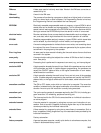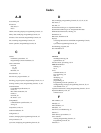
Glossary
108
normal condition See normally open condition.
normally closed condition A condition that produces an ON execution condition when the bit assigned to it
is OFF, and an OFF execution condition when the bit assigned to it is ON.
normally open condition A condition that produces an ON execution condition when the bit assigned to it
is ON, and an OFF execution condition when the bit assigned to it is OFF.
NOT A logic operation which inverts the status of the operand. For example, AND
NOT indicates an AND operation with the opposite of the actual status of the op-
erand bit.
OFF The status of an input or output when a signal is said not to be present. The OFF
state is generally represented by a low voltage or by non-conductivity, but can be
defined as the opposite of either.
OFF delay The delay between the time when a signal is switched OFF (e.g., by an input
device or PC) and the time when the signal reaches a state readable as an OFF
signal (i.e., as no signal) by a receiving party (e.g., output device or PC).
offset A positive or negative value added to a base value such as an address to specify
a desired value.
ON The status of an input or output when a signal is said to be present. The ON state
is generally represented by a high voltage or by conductivity, but can be defined
as the opposite of either.
ON delay The delay between the time when an ON signal is initiated (e.g., by an input de-
vice or PC) and the time when the signal reaches a state readable as an ON sig-
nal by a receiving party (e.g., output device or PC).
one-shot bit A bit that is turned ON or OFF for a specified interval of time which is longer than
one scan.
one-to-one link See 1:1 PC Link.
online edit The process of changed the program directly in the PC from a Programming De-
vice. Online editing is possible in PROGRAM or MONITOR mode. In MONITOR
mode, the program can actually be changed while it is being
operand The values designated as the data to be used for an instruction. An operand can
be input as a constant expressing the actual numeric value to be used or as an
address to express the location in memory of the data to be used.
operand bit A bit designated as an operand for an instruction.
operand word A word designated as an operand for an instruction.
operating modes One of three PC modes: PROGRAM mode, MONITOR mode, and RUN mode.
operating error An error that occurs during actual PC operation as opposed to an initialization
error, which occurs before actual operations can begin.
OR A logic operation whereby the result is true if either of two premises is true, or if
both are true. In ladder-diagram programming the premises are usually ON/OFF
states of bits or the logical combination of such states called execution condi-
tions.
output The signal sent from the PC to an external device. The term output is often used
abstractly or collectively to refer to outgoing signals.
output bit A bit in the IR area that is allocated to hold the status to be sent to an output de-
vice.


















